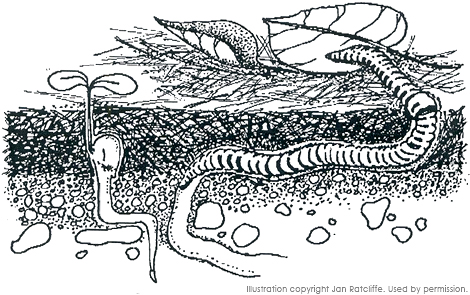Slower Life: The Worms of Spring
Did Charles Darwin retire after spending 20 years on his greatest contribution, On the Origin of Species by Natural Selection? Not likely. But he did slow down, in a sense. Where he had studied pigeons and chickens in his pursuit of inherited traits, he turned in later years to earthworms and plants, where his efforts were equally impressive though far less well known. Why did one of the world’s great scientists spend his last two decades studying the slow details of wormly lives and plant movements, painting his illustrious career into a seemingly obscure corner? No doubt part of the reason was escape from the attention (much of it hostile) his major work had attracted. But the greater reason has to be that he found these topics fascinating. In hundreds of careful experiments he plotted the movements of plants, showing their slow lives to be quite active on a scale difficult for us to perceive with casual observation. He showed that all parts of a plant are in constant motion, leaves and tips describing ellipses and loops in air without our ever realizing it.
Darwin was most impressed by roots, especially that first root of a young seedling, called the radicle. He likened the tip of the radicle to the brain of “lower” animals, guiding and deciding the best route through the soil. He compared the radicle to a wedge driving into the soil, but as it is a living, sensitive, and responsive wedge, he was inspired to say that
“A radicle may be compared with a burrowing animal such as a mole… By continually moving his head from side to side … he will feel any stone or other obstacle, as well as any difference in the hardness of the soil, and he will turn from that side; if the earth is damper on one than on the other side he will turn thitherward as a better hunting-ground. Nevertheless, after each interruption, guided by the sense of gravity, he will be able to recover his downward course and to burrow to a greater depth.”
Much as roots do, earthworms operate as wedges, pushing through soil in a similar fashion, extending a narrow head into an opening, then forcing their wider bodies in to enlarge it. Simple hydraulic action. As roots do, they sense and respond to nuances in the soil that you and I are incapable of detecting. One year during our lengthy wet cycle, I took advantage of the opportunity to conduct my own researches on earthworms. Not being as dedicated to science as Darwin, my experiments were mostly casual and even accidental: I spilled a bag of fresh rabbit manure in the middle of a hard-packed gravel driveway. When I returned a fortnight and several rainstorms later to clean it up, I discovered this tempting offering had attracted earthworms. Although the nearest hospitable soil was more than 20 feet away, they had responded to the dinner bell, that small chemical message sent down through the soil from the first organic material to hit that spot in more than 15 years.
Most of my recent earthworm observations, though, took place on roads. After rain, it’s nice to go out and recover a few earthworms for the garden. I chose some who retained ambition and vitality, as evidenced by their attempts to penetrate the asphalt. (I suspect they fared better before our road—or our world—was paved.) Then I gave them a test, spreading them out on a nice pot of soil. All they had to do was bury themselves to prove they were survivors. After one hour, a big pile of worms remained on the surface. Little movement was visible. After three hours, most of the worms were shorter, having gotten part of their length into the soil. An hour later, the unsuccessful ones got to be a snack for my chickens. (I know what decomposing worms smell like and didn’t need to repeat that experiment.)
Don’t you wonder where all those worms that wash out come from–and where they go? Despite the numerous victims of drowning, desiccation, and squishing, I’m convinced most of them make it back to friendly soil, if only to be forced out again by the next hard rain. A network of worm trails but few bodies in the soft silt this morning bears out this conclusion. As soon as the rain ends and air reenters the soil, they return home. They must, or we’d see none the next time it rained. Many, though, are lost forever: I saw one who had ventured indoors and made it across 20 feet of carpet before expiring into crispiness. Others are brought in by the cat, who doesn’t seem to know what to do with them and simply deposits them in the kitchen. Robins and others are happy to gather as many as they can eat. Some, I assure you, are rescued by a secret society of worm-lovers who venture out after each rain out of high regard for these important creatures.
Part of the reason for Darwin’s research must have been to help the public image of the earthworm, and he eventually even came to respect their intelligence, although keeping them on the piano in the parlor did not endear them to his wife. From most of us, worms get no respect even today. Yet they are always busy, processing and enriching about 18 tons of soil per acre each year. Darwin, in his research, was building on an idea presented earlier by naturalist Gilbert White, that “the earth without worms would soon become cold, hardbound…and sterile.”
Copyright © 2016 Sally L. White
Illustration by Jan Ratcliffe

